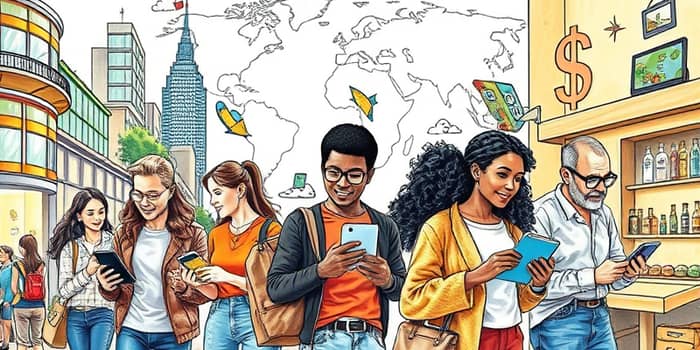
In 2025, consumers around the globe are navigating a complex economic environment, balancing caution with occasional bursts of optimism. Understanding the forces at play is essential for businesses and policymakers alike as they chart strategies for a rapidly evolving marketplace.
Recent research indicates that over 75% of consumers expect to either keep spending flat or reduce it next year. Specifically, 31% plan to spend less, 47% foresee flat spending, and only 19% intend to ramp up expenditures. This reflects a muted global spending intent grounded in lingering inflation concerns and geopolitical uncertainty.
Despite this subdued sentiment, actual consumer behavior is nuanced. Spending in certain categories remains resilient, and strategic splurges in travel or dining out still occur among younger, affluent segments. As companies adjust, they must reconcile cautious sentiment with pockets of robust demand.
Below is a regional snapshot of net spending intent changes:
Consumers in the United States and Europe exhibit widespread restraint. Inflationary pressures, coupled with a cooling labor market, have led to cautious spending plans. In the US, preliminary signs suggest a potential post-election rebound, but concerns about interest rates and housing costs linger.
European consumers grapple with an energy-driven inflation spike and policy uncertainty. Many households have shifted budgets toward essentials, while discretionary categories, such as apparel and entertainment, lose share. In contrast, China and the Middle East display optimism, driven by robust economic growth and cultural factors favoring immediate enjoyment.
In China, 39% of consumers plan to spend more, resulting in a 10% net gain for 2025. The Middle East outpaces even that, with a net 13% rise. These regions demonstrate how economic outlook and consumer mindset interact to shape spending behaviors in significant ways.
One of the clearest shifts is toward staples. More than 80% of consumers expect to maintain or increase grocery budgets, with only 15% planning cuts. By contrast, roughly one-third of respondents intend to reduce spending on non-food retail, and only 16% plan to increase it.
Despite belt-tightening, many consumers embrace a strategy of trading down on routine purchases to afford occasional indulgences. This reflects a broader shift toward value-driven consumer choices, where quality and price intersect in new ways.
In categories such as beauty and personal care, shoppers seek coupon deals and subscription bundles. Retailers respond with tiered offerings, loyalty programs, and personalized recommendations to retain customer engagement even when budgets are constrained.
Age remains a defining factor. Gen Z and Millennials continue to outpace older cohorts in spending growth, with Gen Z’s trajectory projected to be twice as steep as that of baby boomers at the same life stage. By 2035, Gen Z will contribute an additional $8.9 trillion to global consumption.
However, in early 2025 Gen Z spending fell 13% year-on-year, and holiday budgets are set to drop by 23%. This tension between long-term potential and short-term caution underscores a generation that values both immediacy and financial responsibility.
Income segues into a further divergence. High-income households show a net +12% spending intent, while middle-income stands at -7%, and low-income at -20%. Urban consumers, particularly in major metropolitan areas, exhibit greater confidence compared to their rural counterparts, who face limited job opportunities and tighter credit conditions.
Digital channels dominate. Over 90% of consumers in the US and China shopped online in the past month, and nearly 40% ordered groceries via delivery services the previous week. This digital acceleration cements digital-first shopping and engagement preferences.
Home-centric lifestyles also prevail. Elevated grocery and utility costs, combined with health and wellness priorities, drive more at-home cooking, streaming entertainment, and virtual fitness. Brands that support DIY rituals—through recipe kits, online tutorials, or connected devices—gain traction.
Local brands enjoy renewed loyalty, as consumers seek shorter supply chains and community alignment. Emphasizing sustainability and local sourcing becomes a competitive advantage, reinforcing bonds between producers and their neighborhoods.
Consumer credit metrics reveal mixed signals. Delinquencies are rising moderately, yet default rates remain near historical lows. Most borrowers recover quickly, thanks to a still-healthy job market and rising wages among skilled workers.
Buy-now-pay-later options are on the rise, with uptake around 40% in China and 35% in Australia. These services cater to younger shoppers who prefer splitting payments without incurring traditional credit card interest. However, regulators are monitoring potential risks as overall household debt edges up.
Housing market dynamics add complexity. Existing home sales are poised for slight gains in 2025, and lower mortgage rates could spur a rebound in 2026. Home equity continues to underwrite consumer confidence, offering a financial cushion for necessary and discretionary spending alike.
For brands and retailers, adaptability is non‐negotiable. Understanding nuanced consumer priorities—essentials versus splurges, digital versus in-store, local versus global—becomes critical. Companies must pivot quickly to offer value, convenience, and personalization.
Looking forward, brands must monitor the expanding influence of Gen Z, the persistence of inflationary concerns, and the continued digital transformation of commerce. Success in this era will hinge on blending innovation with empathy, delivering practical value while inspiring loyalty.
The consumer landscape in 2025 presents both challenges and opportunities. With strategic foresight and customer-centric agility, businesses can harness shifting spending habits to forge deeper connections, drive growth, and prepare for the dynamic road ahead.
References





